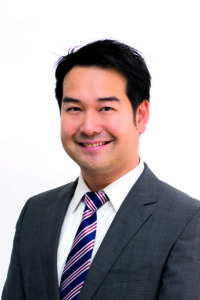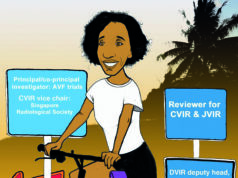 President of the Interventional Radiology Society of Australasia (IRSA) and European Board of Interventional Radiology (EBIR) examiner for Australia and New Zealand, Gerard Goh emphasises the expanding transnational Interventional Radiology landscape, with “greater international collaboration” between major societies. Here, he speaks to Interventional News about how he knew he had found his calling in the “demanding yet rewarding” discipline of interventional radiology, the need to balance innovation with evidence-based clinical research, and how his passion for fast cars led to a stint as a Formula 1 doctor.
President of the Interventional Radiology Society of Australasia (IRSA) and European Board of Interventional Radiology (EBIR) examiner for Australia and New Zealand, Gerard Goh emphasises the expanding transnational Interventional Radiology landscape, with “greater international collaboration” between major societies. Here, he speaks to Interventional News about how he knew he had found his calling in the “demanding yet rewarding” discipline of interventional radiology, the need to balance innovation with evidence-based clinical research, and how his passion for fast cars led to a stint as a Formula 1 doctor.
What initially attracted you to interventional radiology?
Throughout medical school and when I was a junior doctor I wanted to be a surgeon. I loved the technical aspects of procedural work and operations, and the way in which surgery offered patients life changing procedures. As a surgical registrar, I soon discovered that interventional radiology (IR) too offered patients many life changing procedures by using minimally invasive techniques whilst offering quicker recovery times and less morbidity than many surgical operations. In addition, the rate at which innovation in IR was making leaps and bounds inspired me like no other specialty had before. At that moment I knew I had found my calling.
Today, what is it you enjoy most about interventional radiology?
Being able to make such a big difference in a patient’s life and sometimes offering lifesaving procedures gives me great satisfaction as an IR. When I see how patients and their families’ lives are changed by IR, even receiving a simple ‘thank you’ makes me feel proud that we can make such a lasting impact on so many people. I could not do any of this without the support of the great teams of radiographers, nurses and administration staff that I have worked with in both London and Melbourne and I am fortunate to have such great colleagues.
Have you had important mentors throughout your career? What have they taught you?
There have been several IRs who have been mentors to me.
Professor Michael Lee from Dublin helped start my journey in IR. Professor Lee not only taught me many of my skills in IR, but he also taught me the importance of being a clinician. Taking an active role in patient management and having a clinical presence in the wards was much more important than being just a ‘technician’ performing a procedure.
When I was a junior IR at St George’s Hospital, London, I was greatly influenced by my colleagues Anna-Maria Belli and Robert Morgan. Belli and Morgan taught me the importance of leadership, research, and teaching. Research and innovation is an important area in IR, as sound clinical research leads to better patient treatments and outcomes. Teaching IR at all levels from medical students, radiology registrars, IR fellows and even IR peers ensures that knowledge and experience is shared for the advancement of IR overall.
You have worked for most of your career in Australia, but spent four years in the UK. How does the Australian healthcare system compare with the UK healthcare system, in your experience?
Healthcare and IR in Australia and the UK are very similar in many ways, such as the disease processes (although there are many more kangaroo related injuries in Australia), the provision of universal healthcare, as well as the way that medicine is practiced. However, the systems are also different in many ways. A particular strength of the UK system is NICE (the National Institute for health and Care Excellence), for which I was an advisor. NICE provides national guidance and advice for healthcare by using evidence-based assessments and analysis. Even in Australia NICE guidance is often considered at government levels. Australia offers a supportive framework for early clinical and pre-clinical research. The ethics and governance processes for performing first in-human trials as well as early safety and efficacy trials are well established, which facilitates running this kind of research in Australia. It is exciting to be able to assess new technologies and devices and to see how these can offer solutions to challenges we have as IRs in treating patients. We are also able to influence the development and direction of many of these devices and companies to improve the technology. We have been involved with several first inhuman trials as well as safety and efficacy trials, in addition to many other trials, here in Australia. In the UK there are more challenges to performing first in-human trials and early clinical research and although it is not impossible to do so, it is a much more involved process. An interesting observation is that when new technologies are ready for market release, they are often prioritised for approval for use in Europe and the USA, followed by larger countries such as China and Japan first, largely due to corporate sales and marketing strategies. It takes a while for many of these devices to become available in Australia so often a device we have conducted a first in-human trial takes many years before it is available for clinical use, even though we were the first to use it!
Could you explain your current research interests?
I am involved with quite a few different research projects being the head of Radiology Research at my hospital. We are currently heading and involved with several first in-human trials for which I am unable to disclose any details! We are involved with several commercial global studies in some spaces, such as drug coated balloons and inferior vena cava (IVC) filters to name a few. In addition, we have several investigator-initiated projects running that include pancreatic and prostate irreversible electroporation (IRE). We have also recently completed some studies on IVC filters, radiation protection, artificial intelligence in IR and education in IR that are currently being finalised for submission.
Could you describe a particularly memorable case?
I will always remember a minor procedure I performed on a female patient who happened to be a major international entertainment celebrity. The reason why this was so memorable was that although I was treating someone who was famous, escorted by a bodyguard and had to use an alias to avoid unwanted attention, in the IR lab all social barriers were broken down and we were doctor and patient. Even though the procedure was relatively minor and was not a highly stressful life and death situation, at the end of the procedure she was very grateful, commented on how comfortable the experience was, and left with a big smile on her face. It made me realise that Interventional Radiology can make a big impact on anyone regardless if they are an ‘ordinary’ person or someone famous.
As President of the Interventional Radiology Society of Australasia (IRSA), what is your main goal for the society?
My main goal is to work towards recognition of IR as a specialty or sub-specialty in Australia and New Zealand. In our region IR is a reasonably well established specialty amongst our peers; however, we still have much work to do to achieve national recognition similar to that in many other countries, such as in Europe, the USA, and Canada. There is much work to be done in this space and we are working with the Royal Australian and New Zealand College of Radiologists (RANZCR) to achieve this goal. This process will undoubtedly last longer than my term as IRSA president, however I hope that I can guide our society in the right direction towards achieving this goal.
One of the initiatives undertaken in 2014 was when IRSA adopted the Cardiovascular and Interventional Radiological Society of Europe (CIRSE) European Board of Interventional Radiology (EBIR) as a certification of recognition of IR training and an international IR certification for our region. In conjunction with CIRSE and RANZCR, IRSA has held the EBIR exam in Australia and New Zealand annually for the last four years, and this partnership has always been strong. The Australian/New Zealand EBIR sitting is open to all candidates internationally with many candidates taking the exam here instead of in Europe. We have over 75 EBIR holders from Australia and New Zealand and this number continues to grow year by year. The EBIR has helped many IRs in our region show their skills and expertise in IR.
You are an Associate Editor for Journal of Medical Imaging and Radiation Oncology and have been a peer reviewer for many other titles. What do you think makes a good research paper?
A good research paper is one that clearly defines an objective, has a robust methodological approach in investigating this objective, and follows with a thorough detailed critical analysis. Whilst novel research is always exciting, not all research needs to be completely novel, as one can always improve on existing research and expand knowledge. When submitting research to a journal it is always recommended to do some investigating about the journals one intends to submit to. You will be able gauge what kind of research papers a particular journal accepts and tailor your submission accordingly. For those who are new to research I recommend finding a mentor, as their guidance will be invaluable and they will be able to help you improve and build on your research capabilities.
How has the field changed since you started your career?
The most noticeable change I have seen is the greater international collaboration between international IR societies around the world. This helps facilitate the spread of knowledge, and helps IRs network with one another across borders.
CIRSE continues to reach out to non-European IR societies, with many who have joined as group members, IRSA included. As mentioned earlier, IRSA is holding the EBIR in conjunction with CIRSE, offering candidates the chance to sit the exam outside of Europe: a prime example of international IR collaboration. The Society of Interventional Radiology (SIR) is also reaching out to international societies with international group affiliation. The Asia Pacific Society of Cardiovascular and Interventional Radiology (APSCVIR), for which I am an executive committee member, continues to mature as an organisation and has been running outreach programmes where IRs, from regions where IR is well established, travel at their own expense to countries with developing IR programmes (for example Myanmar) to teach IR techniques and share knowledge. This is helpful as not all IRs from these countries have the opportunity to attend international conferences or to gain hands on experience abroad. This year APSCVIR invited delegates from SIR and CIRSE to be involved with the outreach programme for 2019.
Outside of your own research, what is been the most interesting paper that you have seen in the last 12 months?
Although it feels like this was published a long time ago, the ATTRACT trial (pharmacomechnical catheter-directed thrombolysis for deep vein thrombosis) published in the New England Journal of Medicine in December 2017 was probably the most interesting paper I have read in the last year. I like papers that provoke discussion and challenge IRs to do further research. The ATTRACT trial has certainly had its share of controversy and discussion around the world, and many IRs are now looking towards further research in treating Ilio-femoral deep vein thrombosis and May Thurner lesion stenting.
In your opinion, what are the most exciting new developments in interventional radiology that we can expect in the next five to 10 years?
I believe that interventional oncology will continue to grow over the next decade and there will be many developments in both intra-arterial and percutaneous techniques. The technologies will be refined and improved over time and larger scale clinical trials well help guide practice. An area to keep an eye on is immunotherapy, as this is a promising area where modulating the immune system in combination with chemotherapy may help to increase the effectiveness of cancer treatment. This is battling cancer on a molecular level and I believe IR will have role to play in this by helping to deliver or administer treatments.
What is the biggest challenge in interventional radiology at the moment?
The biggest challenge facing Interventional Radiology is to keep up in producing high quality robust clinical evidence for the procedures we perform whilst keeping up with the rapid pace of innovation. If innovation progresses too quickly without the proper research, then it creates many problems, such as inadvertently treating patients with techniques and therapies that may cause more harm than good as well as weaken the credibility of IR. Throughout my career there have been many technologies and innovations that seemed at the time to be revolutionary or evolutionary; however, the subsequent clinical trials have demonstrated that there has been little or no clinical benefit to patients. As we are such a dynamic and innovative specialty we need to be able to produce high quality research that keeps up with the pace of change of technology to ensure that we are able to practice the best medicine for the best interests of our patients.
What advice would you give to someone wishing to start their career in interventional radiology?
Interventional radiology is an exciting, demanding but highly rewarding specialty. IR training will give you a great breadth of knowledge across many different disciplines of medicine and surgery and often IRs will be able to offer treatment when there are little or no options left for patients. An IR will never stop expanding their knowledge. IR allows you to embrace the rapid pace of innovation, but remember that good clinical research is what ensures patients receive the best treatment possible. Most importantly, a good IR needs to be a competent clinician and leader.
 What are your interests outside of medicine?
What are your interests outside of medicine?
I have a black belt in Kung Fu and was previously an instructor for around 16 years. I am currently learning Brazilian Jiu Jitsu. Fast cars are another passion of mine; I currently own a Mercedes AMG, used to do amateur car racing and am a big Formula 1 fan (at one stage I was a Formula 1 doctor). I love travel, having visited 39 countries so far, and I have an Instagram travel blog @funkytyper. I also collect Japanese whisky, with my favourite whisky being 18-year-old Yamazaki.
Fact File:
Current appointments
2014–Present: Consultant interventional and diagnostic radiologist, The Alfred Hospital, Melbourne, Australia
2014–Present: Co-director of training, clinical director of Research, Radiology Research Department, The Alfred Hospital, Melbourne, Australia
2014–Present: Adjunct senior lecturer, Department of Surgery, Monash University, Melbourne, Australia
Current society positions (selected)
2017–19: President, Interventional Radiology Society of Australasia (IRSA)
2017–Present: Executive committee member, Asia Pacific Society of Cardiovascular and Interventional Radiology (APSCVIR)
2015–20: Council member, European Board of Interventional Radiology, Cardiovascular and Interventional Radiological Society of Europe (CIRSE)
Appointments (selected)
2010–14: Consultant interventional and diagnostic radiologist and head of Trauma Radiology, St George’s NHS Foundation Trust, London, UK
2012–14: Honorary senior lecturer and Teacher, St George’s NHS Foundation Trust, London, UK
2009–10: Fellow and clinical lecturer in Interventional Radiology, Royal College of Surgeons in Ireland, Beaumont Hospital, Dublin, Ireland
Awards, grants and prizes (selected)
2017: Alfred Health senior medical staff prize for Clinical/Public Health Research
2015: Outstanding service award, Cardiovascular and Interventional Radiology Journal (CVIR)










